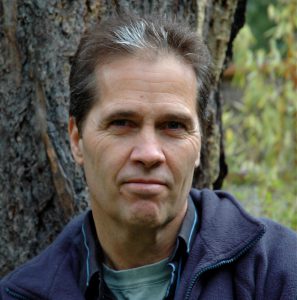For many Alaskans living along the coast, the tides are something we carry around in a little booklet. They can influence decisions about everything from clam digging, to kayaking, to fishing. Although the tides seem pretty reliable and regular, they are one of the most complex natural phenomena in our lives.
KCAW’s Robert Woolsey recently spoke with Jonathan White, the author of a new book called Tides.
Note: Author Jonathan White will sign his book Tides during WhaleFest, this Sunday, November 5, from noon to 1. He’ll read from the book beginning at 6 p.m. on Monday, at Old Harbor Books.
The last time Jonathan White visited Sitka, he knew enough about the tides — like the rest of us — to get by.
“I knew the moon had something to do with it — like a lot of people — but I wasn’t sure what,” says White.
 Unfortunately, however, White did not get by. He had a 65-foot wooden schooner named the Crusader, on which he held natural history seminars. In August 1990, he spent a week cruising near Sitka, and anchored up in Kalinin Bay on the north end of Kruzof Island to wait out a gale.
Unfortunately, however, White did not get by. He had a 65-foot wooden schooner named the Crusader, on which he held natural history seminars. In August 1990, he spent a week cruising near Sitka, and anchored up in Kalinin Bay on the north end of Kruzof Island to wait out a gale.
The Crusader dragged anchor in the night and grounded on the mudflat in an especially big high tide. The next morning the Crusader toppled over.
No one was injured, but Jonathan White discovered a new interest in the tides.
“So I thought that I would read a couple of articles, a couple of books, and pretty much learn everything there was to know about the tide. But I was wrong. The more I read the more fascinating and complex and poetic it became. And so fairly quickly a couple of articles and books turned into 10, 50, 100, and then 300. And two weeks turned into 10 years before I knew it.”
The result is his second book, Tides, from the Trinity University Press. People have known — almost for as long as there have been people — that the tides were connected to the celestial motions of the moon and the sun. The idea that an object might affect another object without touching fell somewhere between heresy and sorcery.
The leading minds of 17th Century couldn’t pull it together.
“Gravity was this unseen force that pervades the universe. And people like Galileo and Descartes really resisted this. They thought that there must be a mechanism — a physical mechanism — by which the movements of the moon and the sun influence the tide. Like using the cue ball in billiards: You hit the cue ball then it hits something else, and it helps something else. And that was how the tides worked.”
It wasn’t until Sir Isaac Newton incorporated gravity into his laws of motion that it all made sense. Nevertheless, White describes Newton as being a bit defensive about gravity, since he had no idea how it worked.
The irony is: We still don’t.
“When Newton introduced it in the late 18th century at the end of the Scientific Revolution, it was the cornerstone that allowed people — all of us — to get a grip, even a fingerhold, on how the tides actually worked. And it’s been 300 years since then, and we know a lot about it, but we don’t know everything.”
White’s book is much more than histor y of science lecture. He looks at tides around the world, through the lens of big wave surfers, and alternative energy enthusiasts. He observes the world’s largest tidal bore in China, and goes mussel-gathering with an Inuit hunter — underneath the ice during a low tide in Canada’s Bay of Fundy. He explains how the little tidebook — ubiquitous in Sitka and other coastal communities in Alaska — contains one of the most complex mathematical calculations in the natural world.
All because the Crusader went aground in Kalinin Bay near Sitka in 1990. In case you’re wondering, here’s how that all worked out.
So the boat went down and got stuck in the mud. And when the tide came back in, it didn’t want to come back up, and instead the tide just flooded the boat. So we were swimming through the boat in chest-deep water about midway through the morning. We sent the crew and passengers back to Sitka in a fishing boat, and I stayed back with a couple of others. Eventually the boat did pop up, and I flushed the engine out through the night. And we got her going again and motored back into Sitka the next morning. Three days later we went out on the next seminar.
And 27 years later, Jonathan White goes out with a deep understanding of tides.































